
95% of researchers rate our articles as excellent or good
Learn more about the work of our research integrity team to safeguard the quality of each article we publish.
Find out more
ORIGINAL RESEARCH article
Front. Environ. Sci. , 13 November 2024
Sec. Soil Processes
Volume 12 - 2024 | https://doi.org/10.3389/fenvs.2024.1488638
This article is part of the Research Topic Nitrate from Field to Stream: Characterization and Mitigation View all 13 articles
Manure application performed in autumn requires regulation due to the risk of nitrogen (N) leaching during winter. On the other hand, application of manure in spring can pose some practical problems depending on the risk for N immobilization and the difficulty in ploughing heavy clay soils during this time of year. The risk for leaching is likely to differ between different soil texture and manure characteristics. In this study, we sought to estimate the risk for nitrogen leaching depending on the carbon/nitrogen ratio (C/N) of the manure, time for manure application, and soil type. We combined 3-year lysimeter experiments with 2-year field plot experiments and laboratory soil incubations and compared results with those from an empirical model. We compared effects of manure application on two soils (silty clay and loamy sand) and solid manures with different representing C/N ratios. In incubations, only manure with a C/N-ratio below 14 contributed with significant amounts of leachable N during the first months after application. In the lysimeter study, N leaching was unaffected by the timing of the application of the manure with C/N-ratio 18. However, regarding manure with C/N-ratio 10, N leaching was elevated with 10–15 kg N per ha after manure application in October compared to November and March on both soil types. The mineral N analyses from soil profiles in the field experiments showed a similar pattern, however, the increase was higher on the loamy sand compared to the silty clay. The ammonia emissions did not differ between manure types, but were on average 24% of applied NH4-N after application in October when air temperature was on average 12°C compared to only 3% of applied NH4-N in November and March when air temperature was on average 5°C. Similar to lysimeter results, the modelled N leaching was higher the earlier the manure application occurred in autumn. However, the model also predicted increased leaching for the manure with a high C/N-ratio, and a smaller effect on leaching on clay soil. Considering this, the model calculations overestimated the leaching effects from manure with a high C/N-ratio and underestimated the leaching effects on clay soil.
Manure application that is carried out in autumn poses a risk for nitrogen leaching during the following winter period, which has a low crop uptake and large drainage runoff (Aronsson et al., 2014), particularly before spring sowing when there is no crop. This risk is therefore dependent on when the manure is applied during the year (Thomsen, 2005). Different manure application times may also mean different time for soil incorporation by ploughing, which can also affect nitrogen leaching (Stenberg et al., 1999; Norberg and Aronsson, 2024). The composition of nitrogen compounds in the manure can also influence whether or not leaching is affected, in which solid manure with less mineral nitrogen can be expected to have an insignificant effect on leaching (Shepherd and Newell-Price, 2016; Pedersen B. N. et al., 2021).
There are currently no reported Swedish leaching experiments regarding solid manure in autumn before a spring crop, but there are results available from Denmark (Hansen et al., 2004; Thomsen, 2005) and the United Kingdom (Smith et al., 2002). Indeed, Thomsen (2005) showed in a lysimeter experiment on loamy sand that nitrate leaching, after application of manure in December and in March, was the same size for unmanured lysimeters, whereas leaching was higher after manure application in September. Moreover, in two parallel plot experiments on a sandy loam with nearly twice as much precipitation as in the lysimeter experiments, Hansen et al. (2004) reported that N utilization was lower after application in both September and December compared to application in spring. This suggests both autumn applications suffered from increased leaching losses. In four experiments on sandy soils in the United Kingdom, application of 200 kg total N with solid farmyard manure in October resulted in an average 4 kg N ha–1 increase in nitrate leaching compared to the unmanured control (Smith et al., 2002). Solid fractions with a C/N-ratio ranging from 7 to 10 from separated slurry also caused a significant increase in N leaching after autumn application to winter wheat in Danish experiments (Sørensen and Rubæk, 2012). Solid manures (>20% DM) may, however, have a larger C/N-ratio and a smaller fraction of mineral nitrogen.
Approximately 40% of the animal farms with cattle and pigs in Sweden have management systems with solid manure and deep litter (SCB, 2020). In 2018/19, 1,800,000 tons of solid manure from cattle, 800,000 tons of deep litter from cattle, and 60,000 tons of solid manure from pigs were distributed on Swedish agricultural land (SCB, 2020). Depending on, for instance, both the type and amount of bedding material as well as the storage time, these types of manure may vary considerably in their chemical composition (Ayadi et al., 2015; Keskinen et al., 2017). A manure from a housing with generous amounts of bedding material, that has also not yet been decomposed during storage, will have a much higher proportion of carbon compared to a manure with less bedding material or a manure that already been degraded during storage. The C/N-ratio for solid beef manure normally varies between 11 and 16 but can also be above 20 from systems with a large amount of straw bedding (Qian and Schoenau, 2002; Loro, 2005). With a higher ratio of carbon compared to nitrogen in the manure, more nitrogen will be immobilized by soil biota and there is consequently less in mineral form (Delin et al., 2012) that is available for crop uptake and leaching. This type of manure can be both more practical and beneficial for crop production to apply and incorporate in autumn, particularly on clay soils whose soil structure benefit from ploughing in autumn compared to spring (Njøs and Børresen, 1991). However, manure application with a lower C/N- ratio in autumn may lead to nutrient leaching during winter (Aronsson et al., 2014) and on lighter soils, where spring ploughing is suitable, manure application in spring has resulted in greater yields of spring-sown cereals compared to application in autumn (Hansen et al., 2004).
In Sweden, the main part of the agricultural land is designated as nitrate vulnerable zones that are regulated by the European Union Nitrates Directive. According to current regulations for manure application within these zones, solid manures may be applied in October but not in November-February prior to spring sowing. The intention of this regulation is to limit nitrogen leaching. However, results from Denmark (Thomsen, 2005) and modelling calculations from Sweden (Johnsson and Hoffman, 1995) both suggest that early autumn application enhances leaching more so than if manure is applied in late autumn. In addition, solid manures may vastly differ in chemical composition and if they pose a risk for leaching or not. The risk may also differ between soils with different texture (Hina, 2024).
Swedish data on how nitrogen leaching is affected by time for application of solid manure depending on manure and soil characteristics would enable a better basis for both regulations and recommendations for farmers that would lead to limited nitrogen leaching. This is important to assure safe water quality and to limit environmental impacts such as eutrophication of our waters. The objective of this study was to describe the nitrogen (N) dynamics following the application of different kinds of solid manures to bare soil in Sweden to estimate the risk for nitrogen leaching during the first year after application depending on the carbon/nitrogen ratio (C/N) of the manure, the time for manure application, and the soil type.
In order to study the effects of solid manure application on several variables, we combined lysimeter experiments with field plot experiments and laboratory soil incubations. The lysimeter experiments were included to study nutrient leaching and the field experiments to study ammonia emissions, grain yield, and soil mineral nitrogen profiles. In the soil incubations we studied the course of net N mineralisation for a greater number of manures. In all experiments, the same two soils representing clay soil and sandy soil (Table 1) and the two manure types representing a high and low C/N-ratio (Table 2) were included. Manure A, which represented a solid farmyard manure with a relatively low C/N-ratio of 10, originated from a sow stable with moderate amounts of straw bedding compared to a deep litter. Manure B represented a solid manure with a relatively high C/N-ratio of 18 and was acquired from a deep litter for dairy heifers. The lysimeter facility and one of the field experiments were located at Lanna Research Station (58°20 N, 13°7 E) and another field experiment was located at Fotegården (58°28 N, 13°14 E), 17 km north from Lanna (Figure 1). Weather data was only recorded at Lanna (Figure 2), but data from a weather station in close to Fotegården confirms that temperatures are very similar and that precipitation may be a bit higher at Fotegården. The hydrological year (July-June) 2014/2015 had unusually high precipitation in August and a milder winter than usual (Figure 2).
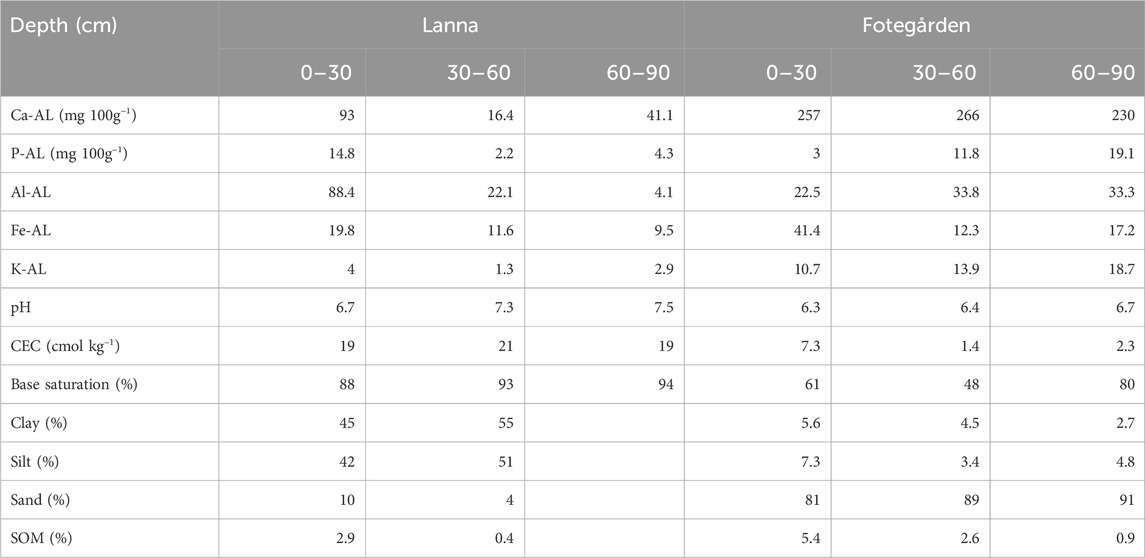
Table 1. Soil characteristics for the two soils used in lysimeters, field experiments, and incubations (where only the 0–30 cm is relevant for the incubations).
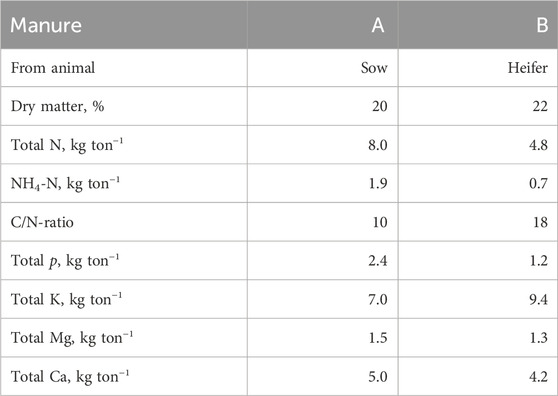
Table 2. Characteristics of the two types of manure used in lysimeters, field experiments, and incubations.
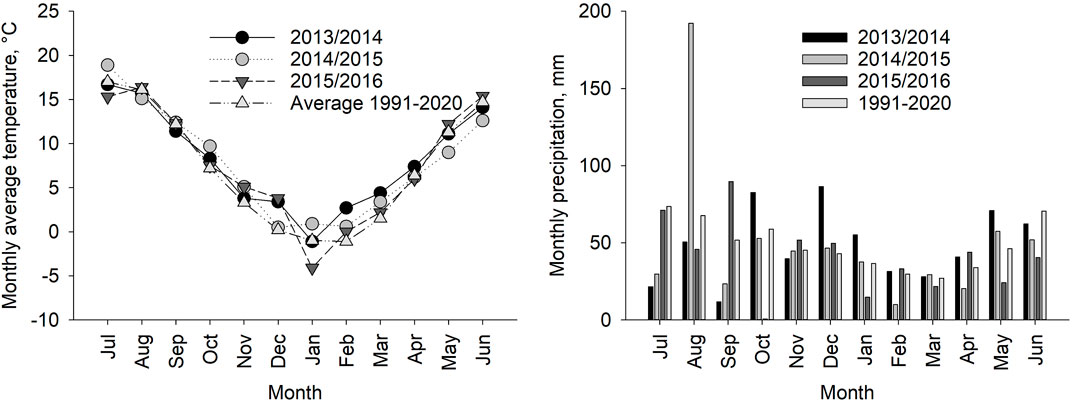
Figure 2. Monthly averages of air temperature and monthly accumulated precipitation at Lanna research station during the experimental period.
Two 2-year field experiments were conducted on fields with different soil conditions (Table 1). One field had loamy sand at the farm Fotegården. For that experiment, three different times of application of two different solid manures (Table 2) were compared with two unmanured controls with different levels of mineral nitrogen fertilizer (Table 3). The lower level of mineral fertilizer was the same as in manured treatments and the higher similar as the expected N fertilization effect of manure N. These treatments were included for comparison, to evaluate the effects of manure N. The other experiment was located at Lanna Research Station in a field with silty clay soil (Table 1). For this experiment, the times for manure application were limited to the two times in autumn and with only one of the manures (Table 3). The reason for the limitation of application times at this site was that this type of soil would not be feasible to plough in spring. To limit costs, only the manure type that was expected to have larger impact on yield and soil mineral N levels was included. The experiments had a randomized block design with three replicates at Fotegården and four replicates at Lanna. Each individual plot was 4 m wide and 15 m long. The experiments were established in autumn 2013 starting with manure application according to plan (Table 3) and was finished after harvest in 2015.

Table 3. Treatments in the field experiments where × indicates which treatments are included at the sites Lanna (L) and Fotegården (F).
Manure amounts corresponding to approximately 150 kg total N ha–1, i.e. 20 tons ha–1 of manure A and 30 tons ha–1 of manure B were distributed within the plots using pitchforks. Ammonia emissions were measured from the time of application until ploughing, which was approximately 24 h. For this, an equilibrium concentration method dynamic technique, with chambers and passive diffusion samplers, was used (Svensson, 1994). In each plot with manure application, one or two 0.3 m × 0.4 m large metal frames were inserted into the soil on which ventilated chambers were then placed. We put one diffusive sampler both inside and outside each chamber to estimate the equilibrium concentration using Equation 1. To determine suitable exposure periods, the NH3 concentration in the ventilated chambers was measured with detection tubes. This usually resulted in one sampler during the first 3–5 h and a new one for the remaining 19–21 h. To ensure the correct manure amount where ammonia emissions were carried out, the amount of manure applied within the frames was weighed separately on a finer scale.
Where E is the ammonia emission, Ceq denotes the equilibrium concentration of NH3 measured inside the chambers, Ca the ambient NH3 concentration measured outside the chambers and KZ the mass transfer coefficient which was set to 10 mm s–1 (Svensson and Ferm, 1993).
The ploughing, harrowing, and sowing was all performed with conventional equipment. Mineral fertilizer corresponding to 40 kg N ha–1 was applied in all plots with a boom fertilizer spreader in connection to sowing. Another 40 kg N ha–1 was applied in the 80 kg N ha–1 treatment with a plot spreader. The grain yield was measured with a plot combine in 20 m2 large areas within each plot and grain samples were taken plot-wise for an analysis of nitrogen content using near infrared transmission (NIT) spectroscopy.
Soil samples were taken in March 2014, February/March 2015, and September 2015 for determination of mineral nitrogen (NH4-N and NO3-N) in the soil profile. For this, 18 cores from the 0–30 cm soil layer, 9 cores from the 30–60 cm, and 60–90 cm depths were mixed to composite samples for each plot and depth. The samples were stored at a frozen temperature until analysis. The samples were milled and homogenized in a frozen state. Subsamples of 40 g were extracted with 100 mL 2 M KCl (Mulvaney, 1996). The ammonium (NH4+) and nitrate (NO3-) analyses were then carried out using colorimetric methods on a Seal AA3 auto-analyzer (SEAL Analytical Inc., Mequon, Wisconsin, United States).
Differences in yield and mineral N in subsoil was analyzed statistically with one-way ANOVA for each location and occasion separately. Tukey’s test (confidence interval of 95%) was used to investigate differences between the treatments. To verify assumptions for ANOVA, normal probability tests were performed in Mintab.
Differences in N leaching between treatments with three different times of application of the two different solid manures (Table 2) was compared with an unmanured control in a lysimeter experiment (Table 4) involving the two soil types (Table 1). The treatments were the same as in the field experiments, except there was only one unmanured control. For the collection of undisturbed soil monoliths for the experiment, we used a drilling technique described by Persson and Bergström (1991). To carry out this method, we used a corer consisting of a steel cylinder with cutting teeth at the bottom, into which plastic pipes were inserted to encase the soil columns. The steel cylinder rotates and carves out soil cores that were gently pushed into the pipes. The lysimeter containers had an inner diameter of 0.295 m, a length of 1.18 m, and were made of polyvinyl chloride (PVC). This depth correspond to the standard drainage depth of around 1 m on Swedish agricultural soils, which means that water collected at this depth represents drainage water. Twenty-one soil columns with loamy sand, that were 0.8 m in length, were collected from the same field that was used in the field experiment at Fotegården. This slightly more shallow depth was chosen for practical reasons, as deeper soil cores required much more force from the drill leading to compacted and unrepresentative soil columns. A further nine soil columns with silty clay soil were used from a field nearby the field experiment at Lanna. The monoliths were collected in June 2013 and then stored in a cool barn for 6 weeks before they were entered into the ground in the lysimeter facility, which was placed at Lanna, around 500 m from the field experiment on clay soil. Grass was sown between the lysimeters, in order to reduce the weather exposure of the crop. The construction was very similar to the one decribed by Bergström and Johansson, (1991) with water sampled underground individually for each lysimeter.

Table 4. Treatments in the lysimeter experiment and corresponding treatment 1-8 in field experiments (Table 3) at Lanna (L) and Fotegården (F).
The manure was homogenized and divided into 205 g and 137 g large portions of heifer and sow manure respectively, to correspond to 20- and 30- tons ha–1 or roughly 150 kg ha–1 total N when applied to the lysimeters. For the homogenization we first used scissors to cut the straw in the manure into 2–3 cm long pieces, before mixing it all with a spoon. The portions were stored in the freezer until manure application during the following 3-year period. Manure was applied in either October, November or March depending on treatment (Table 3) during three consecutive years starting in autumn 2013. Prior to manure application, the upper 15 cm of soil was removed and placed in a bucket. The manure was then applied, and the removed soil was returned on top. This procedure simulated manure application with immediate incorporation by ploughing. We only carried out this procedure once per year in each lysimeter, meaning that they had different ploughing times depending on time for manure application. For the unmanured treatment, ploughing was simulated in this way in October in 2013 and 2015 and in November in 2014. To avoid any difference in plant cover for different treatments (which could affect leaching) weeds were removed in all lysimeters at all times of manure application.
In the years following manure application (2014–2016) and the next year with continued leaching measurements (2017), spring cereals were grown with spring oats in 2014 and 2016, spring barley in 2015, and spring wheat in 2017. The sowing was done by hand in three rows with a 10 cm distance. In addition to the applied manure, all lysimeters received mineral N fertilizer as 50 kg N ha–1 broadcasted ammonium nitrate (YaraBela AXAN) immediately after sowing. Weeds were removed by hand shortly after emergence. The crop was harvested at ripening by cutting the straw 10–15 cm above ground. Due to birds and moles eating parts of the harvest in 2014 and 2015, the yield measurements from the lysimeters are unreliable and thus not presented.
The drainage water from each lysimeter was assembled in containers placed underground in basement and transported in connecting pipes through free drainage. This water was sampled every second week during periods with enough drainage water (>40 mL per lysimeter) after which the containers were emptied. Throughout the periods with very large amounts of drainage water, sampling was done with only a 1-week interval, to avoid overflow in the water collection containers. During the first few months (until March 2014), the accumulated drainage runoff for the sampling period was measured in connection with sampling. After this, scales with continuous logging were installed and values for drainage runoff were logged for each 15 min period.
The total N concentrations in drainage water were determined by using the combustion method, according to the European standard (SS-EN 12260:2004). The instrument used was TOC-VCPH, including TNM-1 and ASI-V (Shimadzu). The sum of N in NO3- and NO2- was determined by the photometric method according to the standard SS-EN ISO 15293–1:2013, and the instrument used was a Gallery Discrete Analyzer (Thermo Fisher Scientific).
Nitrogen leaching was calculated for each lysimeter by multiplying the measured drainage volumes by its nitrogen concentration for each sampling period. The calculated leaching was then summarized for each year ranging from 1st October until 30th September. Differences in yearly leakage between treatments on the sandy soil were analyzed using a three-way factorial ANOVA with manure type, soil type, and application time as the independent variables. Tukey’s test (confidence interval of 95%) was used to investigate differences among treatments. To verify assumptions for ANOVA, normal probability tests were performed on the residuals. Only for the very last dates of nitogen concenteration, assumptions were not met. For this data, the Box-cox transformation options “No transformation” and “Optimal λ” were tested to see if transformation was required. Since data transformation did not have any significant effects on the results, the results of comparing non-transformed data are presented.
Two incubation experiments were performed for this study. In the first, the relations between mineral N content in soil after manure addition and the C/N-ratio of the manure was studied using thirteen different manures from various animals (cattle, pigs, sheep, horses and minks) and the loamy sand soil from Fotegården (Table 1). In the second incubation, the effects of soil type on mineral N content in soil was studied by repeating the incubation with two manures (Table 2) on the silty clay soil from Lanna (Table 1). The incubations were performed in metal cylinders that were 5 cm high and 7 cm wide. Manure corresponding to 6-ton dry matter ha–1 was sandwiched between two layers of soil that was watered to 50 or 60% of water holding capacity on the silty clay and loamy sand, respectively. The cylinders with loamy sand were prepared by adding 125 g soil, then the manure and finally another 125 g of soil. Due to the soil structure of the silty clay, it could not be prepared in the same way. Instead, those cylinders were taken out from the field. When arriving in the lab the soil was gently pushed so that half the column entered a second cylinder, and it was then divided into two parts with a knife. After adding the manure to one of the half-filled cylinders, the other half could be returned. To obtain equal amounts of soil in all the cylinders, some soil was removed from each one until the soil weight reached 300 g. The reason for adding the manure as a layer in the middle, rather than mixing it with the soil, was to imitate when manure is incorporated by ploughing and to retain a field like structure of the silty clay.
The cylinders were placed in 10°C and sampled after 0, 7, 28 and 56 days. To prevent the soil from drying out and to also maintain an aerobic environment, the cylinders were placed on grids in closed boxes that were aerated at least twice a week. A sufficient amount of cylinders were prepared to sample three replicates at each sampling date. At sampling, the whole cylinders were poured into plastic bags and put in the freezer. The samples were milled in a frozen state and subsamples of 40 g were extracted with 100 mL 2 M KCl (Mulvaney, 1996). The ammonium (NH4+) and nitrate (NO3−) analyses were then carried out using colorimetric methods on a Seal AA3 auto-analyzer (SEAL Analytical Inc., Mequon, Wisconsin, United States).
From the results the amount of mineral N supplied from manure addition to soil was calculated by subtracting the min N content from the unmanured control. This is hereafter referred to as Net mineral N release, expressed as % of added total N. It provides a measure of potentially plant-available N from manure, and was calculated according to Equation 2:
To ensure the results from these experiments were in line with models that describe nitrogen leaching after manure application, nitrogen leakage was calculated using the NLeCCS system (Johnsson et al., 2022), which includes the SOILNDB simulation tools (Johnsson et al., 2002). This system is used for calculations of leakage to report to different commissions for water protection (HELCOM, OSPAR and EEA). The model setup from the PLC6-calculations was used (Johnsson et al., 2016). The NLeCCS method calculates nitrogen leaching from arable land, using a 30-year climate data series assumed to represent normal climate. Climate conditions and agricultural management represent leaching regions. The climate series was run a total of 500 times with a crop sequence that included the crops grown in the leaching region in the proportion reported by Statistics Sweden (SCB, 2014). Also, the fertilizer regimes (Only mineral fertilization and Manure fertilization with supplementary mineral fertilization) were distributed in the crop sequence according to Statistics Sweden (SCB, 2014). The calculated leaching region was lr 5a (Johnsson et al., 2016).
Calculations of nitrogen leaching after application of manure at five different points between 30 September and 14 March, before sowing of spring barley, was made for a crop sequence where manure application occurred a sufficient number of times. Ploughing was carried out the day after manure application. Calculations were made for similar soil types (clay and sandy loam) and for manure types with similar C/N-ratios and ammonium contents as in our experiments, as well as the leaching region where the experiments were performed.
The measured increase in mineral N content in soil directly after manure addition correlated well (r2adj = 0.92***) but was only about 80% of what was added with manure (Figure 3A). Also, after 7, 28, and 56 days there was a strong correlation (r2adj = 0.84–0.89***), but with somewhat flatter regression lines (Figure 3A). The later measurements indicated a net immobilisation of around 25% of the added ammonium N until day 56 in the treatments with the highest amounts of ammonium added, while for the manures with initial low contents of ammonium N added there was a slight net mineralisation of up to 4% of total N added. There was not any significant correlation (r2adj = 0.18–0.30) between the C/N-ratio of the manure and net mineral N release to soil from manure addition, although there was a tendency (p = 0.06) for exponential decay (Figure 3B). However, none of the manures with C/N-ratios above 11 resulted in mineral N contents above 15% mineral N of added total N at any time throughout the measuring period.
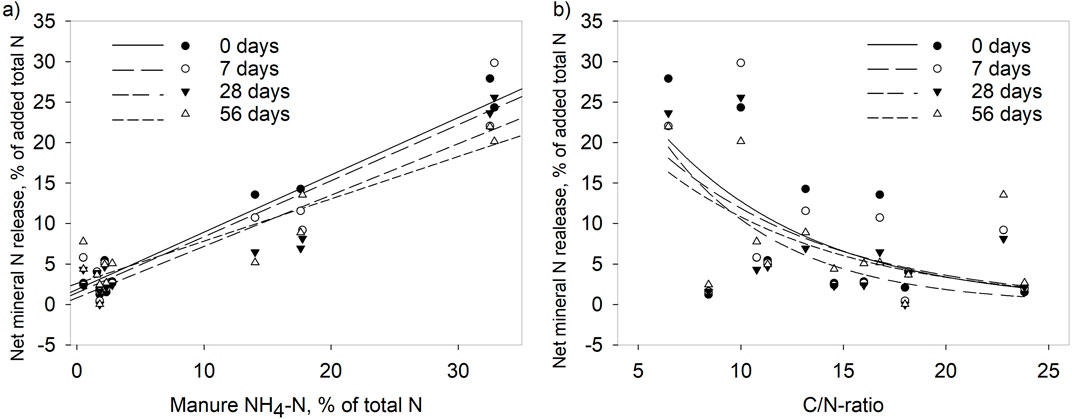
Figure 3. Results of incubations showing net mineral N release from manure addition expressed as percentage of total N added with manure and plotted against (A) manure content of NH4-N and (B) manure C/N-ratio.
The nitrogen concentration in drainage water was higher during certain periods in treatments B and I, which are the treatments where manure A (with a low C/N-ratio) is applied in early autumn on loamy sand and silty clay respectively (Figure 4). In treatment B (on sandy soil), the nitrogen concentration was significantly higher compared to other treatments on that soil in sampling dates from 19 January 2015 until 31 March 2015. This means a time lag of 3.5 months between surface application in beginning of October until significant effect appeared in leachate. In treatment I (on silty clay) the nitrogen concentration was significantly higher than in the treatment without manure on that soil, and occasionally also higher than in the treatment with later manure application, during the period 13 November 2014 until 7 January 2017, which is a time lag of only 1.5 months between surface application and effect on leachate.
During the first year of measurement (1 October 2013–30 September 2014), the nitrogen concentration was unusually high in all treatments, likely due to mineralisation of dead plant material during the period after drilling up the soil monoliths. Therefore, the focus is hereafter mainly given to the two following years (1 October 2014–30 September 2016), as they could be considered to better mirror a field situation. Due to the high nitrogen concentrations in drainage water during the first year of measurements, leaching during this year was also high and ranged from 58 to 119 kg N ha–1. The highest leaching that was measured within each soil type was in the treatments with early autumn application of manure A, but there were no significant differences within the soil types. For the two following years (Figure 5), early autumn application of manure A was significantly higher in both years on the silty clay and in the year 2014/2015 on the loamy sand. The evaluation was on average for both years 10 kg N per ha on loamy sand (p = 0.07) and 15 kg ha–1 on silty clay (p = 0.02) compared to application in November (Figure 5).
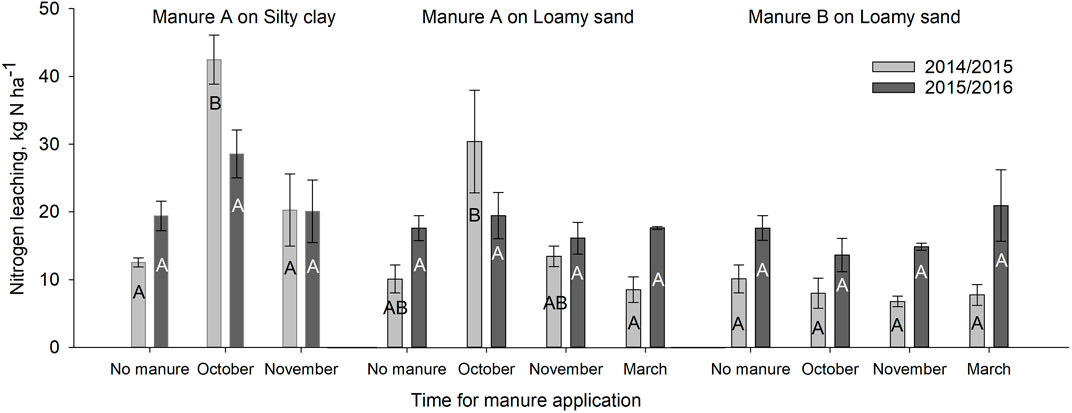
Figure 5. Yearly nitrogen leaching throughout the years (October-September) following the manure applications 2014/2015 and 2015/2016 which compare treatments with manure application applied at different times of the year for each manure type and soil type separately. Error bars show standard error, and the same letter indicates that the treatments are not significantly different from other treatments with the same soil and manure type within the same year.
The grain yield was similar between application times of manure, with no significant yield differences on the loamy sand (Table 5). However, on the clay soil the yield was significantly lower after application in November compared to October (Table 5).
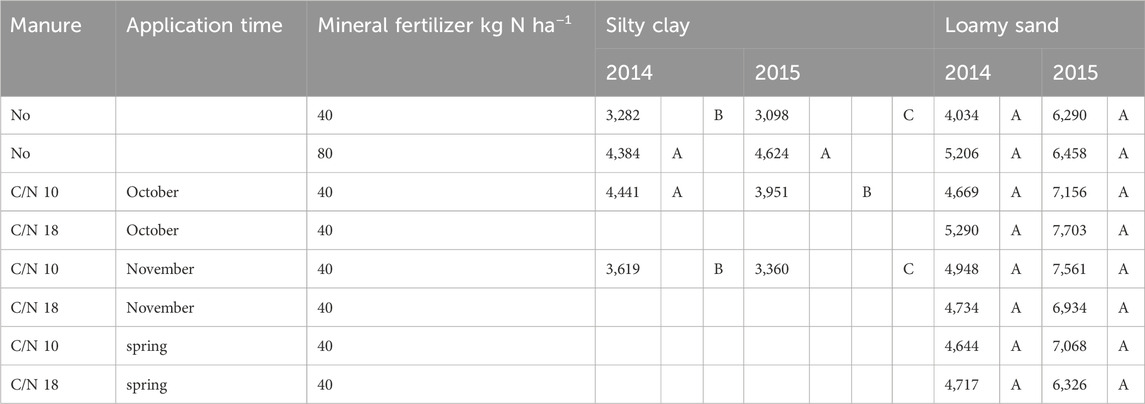
Table 5. Grain yield in the field experiments at the two sites during the two different years. The same letter indicates treatments do not differ significantly (p < 0.05) within that experiment.
The measured ammonia emissions varied between 0% and 40% of applied NH4-N (Table 6). The emission was positively correlated with temperature (Figure 6). The average temperature after manure application in October was 10°C, which resulted in an average ammonia emission of 24% of NH4-N. In November and March, the temperatures were on average only 3°C and 5°C and the average ammonia emissions were limited to 4% and 2% of NH4-N respectively. The differences in ammonia emissions between occasions with high temperatures could not be explained by differences in wind speed. There were no significant differences in emissions depending on manure or soil type, although the emissions on clay soil appeared as though they were larger (Figure 6).
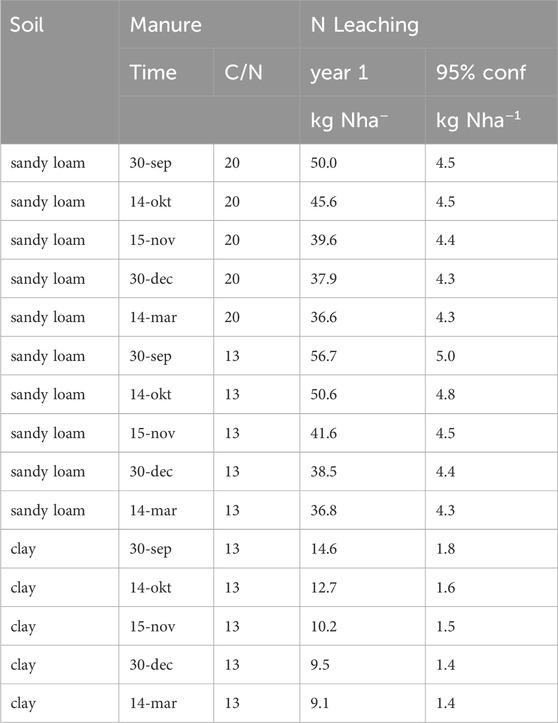
Table 6. Nitrogen leaching, including 95% confidence interval (95%conf), according to calculations made with the NLeCCs system (Johnsson et al., 2016) with different manure application times, soils, and C/N ratio.
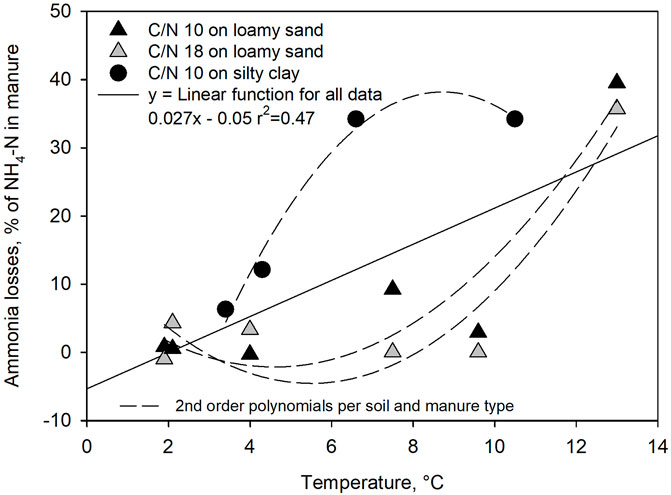
Figure 6. ammonia emission from manure application until ploughing (20 h) depending on temperature after application with the two manure types on the two soil types.
On clay soil, soil mineral nitrogen in the subsoil (30–90 cm) was elevated with 8 kg N ha–1 in March 2014 after application of manure A in October compared to application in November or no manure application (Figure 7A). In the following year, there was no significant differences found in soil mineral nitrogen in the subsoil (30–90 cm) between any of the manured treatments and the unmanured control (Figure 7B). On the sandy soil, application of manure A at both times in autumn and in both years elevated the soil mineral N content in subsoil in February-March with 10–18 kg N ha–1, although in the second year this was not statistically significant (p = 0.09) (Figures 7C, D). Application of manure B did not lead to any significant elevation of soil mineral nitrogen in subsoil (Figures 7C, D).
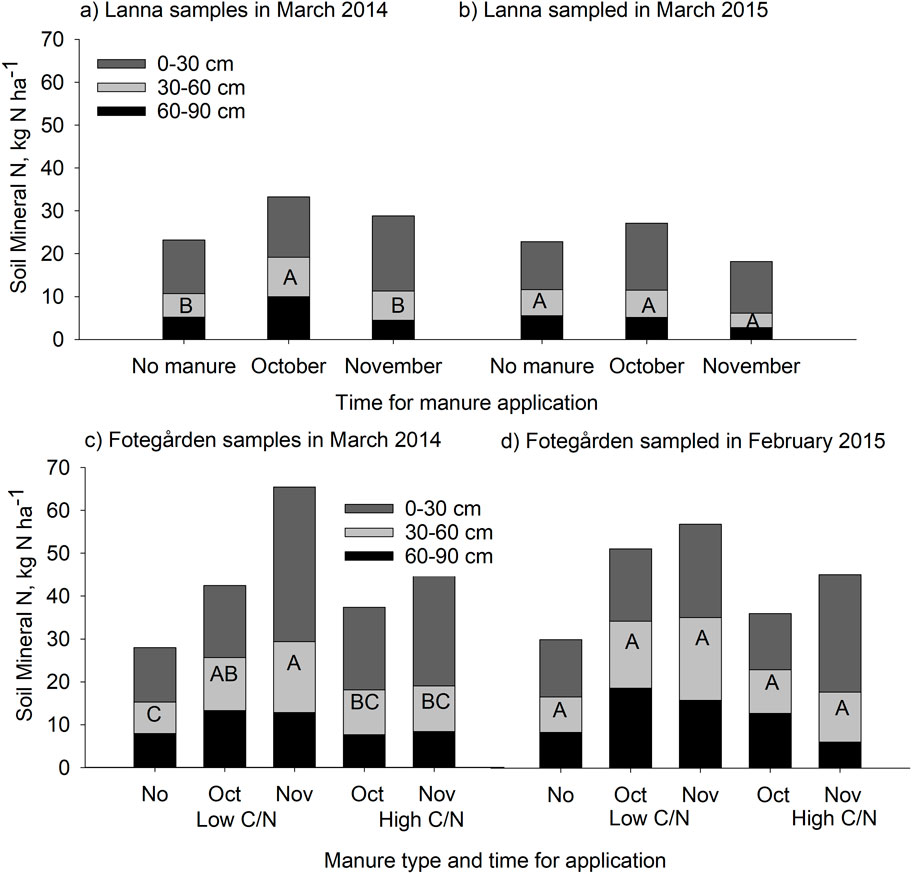
Figure 7. Soil Mineral N in soil profiles in the experiment at Lanna in (A) March 2014 and (B) March 2015 and in the experiment at Fotegården in (C) March 2014 and (D) February 2015. Bars that don’t share the same letter differ significantly (p < 0.05) in soil mineral N content in the subsoil (30–90 cm depth).
The nitrogen leaching during the first year after manure application, as calculated according to the NLeCCS system (Table 6), was higher the earlier the manure application was carried out before sowing. Leaching was higher after manure application in the autumn and when the ammonium content of the manure was higher and the C/N-ratio lower, but any differences depending on these manure characteristics were rather small (Table 6). Differences in leaching between soil types were high with small differences concerning the effect on leaching between earliest and latest application date on the clay soil compared to on the sandy loam (Table 6).
The lysimeter study showed a similar trend of leaching from the silty clay as from the loamy sand (Figure 5). Likewise, the mineral N content in the soil profiles that were taken in late winter or early spring in the field experiments (Figure 7) reveal that nitrogen from manure applied in early autumn has moved down to the subsoil on both soil types in 2014. However, in the lysimeters, the leaching effects tended to be higher on the silty clay, whereas in the field experiments the increased mineral N content in subsoil was half as much on the silty clay as on the loamy sand. The higher transport of mineral N in the lysimeter could be due to edge effects in the lysimeter. As the soil dries, large cracks are formed in this type of soil, both in the field and in the lysimeters. However, cracking along the edges in the lysimeter may have increased this effect, which is also indicated by the quite short time lag of only 1.5 months between manure application and effect on leachate on this soil compared to 3.5 months on the lighter soil. The lighter soil was lacking macropores, and therefor had a slower response on drainage from heavy rainfall than the structured silty clay soil. Another observed difference is that on the loamy sand, there was no difference in subsoil mineral N between the two different application times in autumn, whereas on the silty clay subsoil it was only elevated after late autumn application, similar to the lysimeter experiments. The somewhat lower effect on the clay soil shown in the field experiments exhibits a closer similarity with previous observations at Lanna (Aronsson and Stenberg, 2010) and from fine textured soils in general (Hina, 2024). Since low leaching from clay soils are, at times, explained by assumed higher denitrification losses (Aronsson and Stenberg, 2010) which occur on water saturated soil (Bouwman, 1996), one could speculate that the denitrification losses may have been smaller in the lysimeters. Indeed, because they often appeared to be dry, they may never have become as saturated with water, which can be the case under field conditions when ground water level occasionally rises above the drainage depth, since that should not be possible in the freely drained lysimeters. However, Wallman and Delin (2022) found from measurements of drainage water from lysimeters in the same facility and within the same soil from the same field, that leaching levels were similar to those measured from a tile drained field facility in that very same field where the lysimeters were collected. Hence, the large effects on leaching that also occurred on the silty clay cannot be ignored.
The modelled higher leaching with earlier manure application (Table 6) was in accordance with the results with Manure A in the lysimeter study. However, as opposed to the lysimeter study where the effects of Manure B on leaching were insignificant, the effect of manure application according to the model was very similar regardless of the ammonium content or the C/N-ratio. Negligible leaching after application of manure with a high C/N-ratio, as found in the lysimeter study, is supported by previous literature (Shepherd and Newell-Price, 2016; Pedersen B. N. et al., 2021). This implies that the effect of the C/N-ratio is underestimated by the model. Another disparity between the modelled and experimental results were the differences between the soil types. According to the model, leaching effects on the clay soil were rather small compared to lighter soil which is in line with other publications (Hina, 2024), as discussed above. Considering both the literature (Hina, 2024) and the results from the field experiments (Figure 7) the modelled effects of soil type may be more representative than what was observed in the lysimeter study.
The leaching results after application of the low C/N-ratio manure were in line with those found by Thomsen (2005), who also concluded that manure applied in early autumn increased leaching losses compared to later applications that were carried out in winter or spring. However, Thomsen (2005) and Hansen et al (2004) also found that early application improved crop N utilization, which was not applicable to the results in our field experiments, in which the yield was unaffected on the loamy sand and affected in the opposite direction on the clay soil. Reduced crop yield after late compared to early autumn ploughing was, on the other hand, in accordance with results from Stenberg et al. (1999), who suggested this to be an effect of increased growth of weeds in the late ploughed treatment. That there is a temperature dependence of ammonia emissions from manure is known from previous research and the increase from less than 5% to 20%–40% with higher emissions at fine textured soils is in line with what Pedersen J. et al. (2021) presented for animal slurries with high DM content.
The results indicate that the risk for leaching after autumn application differ depending on the composition of the manure. Therefore, restrictions may only be relevant for manure with C/N-ratios below 14 or based on the amount of ammonium nitrogen content. Applying the manure late rather than early was unbeneficial for yield as opposed for leaching and current restrictions that only allow application before a certain date does not serve any purpose when it comes to the limitation of leaching. If farmers find it better to apply the manure later, it could also benefit from lower leaching.
The results confirm that the risk for leaching is dependent on the nitrogen and carbon composition of the manure. According to the results in this study, the risk for leaching is predominantly for manure with a C/N-ratio below 14 and the amount of leachable nitrogen is very similar to the amount of mineral nitrogen that was applied from the start. Nitrogen leaching was higher after application of manure with a low C/N-ratio in October compared to both November and April. It was affected similarly on clay soil as on sandy soil, however, indications from soil profiles suggest that leaching from clay soil may be smaller under field condition, as indicated by model calculations. The lower ammonia emissions at cooler temperatures later in the autumn also support that manure application would cause lower nitrogen losses in total after application late rather than early in the autumn. Only on clay soils, when soil conditions in late autumn may be too wet to succeed with ploughing without soil structural damage and therefore lower crop yield, earlier application can be motivated.
The raw data supporting the conclusions of this article will be made available by the authors, without undue reservation.
SD: Conceptualization, Funding acquisition, Investigation, Project administration, Visualization, Writing–original draft, Writing–review and editing. KM: Formal Analysis, Writing–review and editing. HJ: Formal Analysis, Writing–review and editing.
The authors declare that financial support was received for the research, authorship, and/or publication of this article. This study was funded by the Swedish Research Council FORMAS (grant number 2012-00676).
Thanks to Ingrid Thomsen at Aarhus University for valuable guidance during the planning of this project, especially concerning the incubation experiments. Thanks to Lars Bergström for advice, Rolf Tunared for construction and Göran Johansson, Maria Stenberg and Tobias Carlsson for practical assistance with the lysimeter facility. Thanks to the staff at Lanna Research station for assistance with experiments in the field and in lysimeters. Thanks to all the farmers that contributed with manure and to the farmers at Fotegården that gave access to their land and their soil. Thanks also to Martin Ferm for supervision regarding ammonia emission measurements.
The authors declare that the research was conducted in the absence of any commercial or financial relationships that could be construed as a potential conflict of interest.
All claims expressed in this article are solely those of the authors and do not necessarily represent those of their affiliated organizations, or those of the publisher, the editors and the reviewers. Any product that may be evaluated in this article, or claim that may be made by its manufacturer, is not guaranteed or endorsed by the publisher.
The Supplementary Material for this article can be found online at: https://www.frontiersin.org/articles/10.3389/fenvs.2024.1488638/full#supplementary-material
Aronsson, H., Liu, J., Ekre, E., Torstensson, G., and Salomon, E. (2014). Effects of pig and dairy slurry application on N and P leaching from crop rotations with spring cereals and forage leys. Nutrient Cycl. Agroecosyst. 98, 281–293. doi:10.1007/s10705-014-9611-3
Aronsson, H., and Stenberg, M. (2010). Leaching of nitrogen from a 3-yr grain crop rotation on a clay soil. Soil Use Manag. 26, 274–285. doi:10.1111/j.1475-2743.2010.00277.x
Ayadi, F. Y., Spiehs, M. J., Cortus, E. L., Miller, D. N., and Djira, G. D. (2015). Physical, chemical, and biological properties of simulated beef cattle bedded manure packs. Trans. ASABE 58, 797–811. doi:10.13031/trans.58.10962
Bergström, L., and Johansson, R. (1991). Leaching of nitrate from monolith lysimeters of different types of agricultural soils. J. Environ. Qual. 20, 801–807. doi:10.2134/jeq1991.00472425002000040015x
Bouwman, A. F. (1996). Direct emission of nitrous oxide from agricultural soils. Nutrient Cycl. Agroecosyst. 46, 53–70. doi:10.1007/bf00210224
Delin, S., Stenberg, B., Nyberg, A., and och Brohede, L. (2012). Potential methods for estimating nitrogen fertilizer value of organic residues. Soil Use Manage. 28, 283–291. doi:10.1111/j.1475-2743.2012.00417.x
Hansen, E. M., Thomsen, I. K., and Hansen, M. N. (2004). Optimizing farmyard manure utilization by varying the application time and tillage strategy. Soil Use 20, 173–177. doi:10.1111/j.1475-2743.2004.tb00353.x
Hina, N. S. (2024). Global meta-analysis of nitrate leaching vulnerability in synthetic and organic fertilizers over the past four decades. Water 16, 457. doi:10.3390/w16030457
Johnsson, H., and Hoffmann, M. (1995). Beräkning av kväveutlakning vid olika spridningstidpunkter för stallgödsel. Avdelningen för vattenvårdslära, Sveriges lantbruksuniversitet. Teknisk rapport 11.(In Swedish)
Johnsson, H., Larsson, M., Mårtensson, K., and Hoffmann, M. (2002). SOILNDB: a decision support tool for assessing nitrogen leaching losses from arable land. Environ. Model. and Softw. 17, 505–517. doi:10.1016/S1364-8152(02)00013-0
Johnsson, H., Mårtensson, K., Lindsjö, A., Persson, K., Andrist Rangel, Y., and Blombäck, K. (2016). “Läckage av näringsämnen från svensk åkermark,” in Beräkningar av normalläckage av kväve och fosfor för 2013. SMED Rapport Nr 189 2016. (In Swedish).
Johnsson, H., Mårtensson, K., Lindsjö, A., Persson, K., and och Blombäck, K. (2022). NLeCCS – a system for calculating nutrient leakage from arable land. Ekohydrologi 177. Uppsala: Sveriges lantbruksuniversitet.
Keskinen, R., Saastamoinen, M., Nikama, J., Särkijärvi, S., Myllymäki, M., Salo, T., et al. (2017). Recycling nutrients from horse manure: effects of bedding type and its compostability. Agric. Food Sci. 26, 68–79. doi:10.23986/afsci.60443
Mulvaney, R. L. (1996). “Nitrogen—inorganic forms,” in Methods of Soil Analysis, Part 3-Chemical Methods. Editor D. L. Sparks, A. L. Page, R. H. Helmke, P. N. Leoppert, M. A. Soltanpour, C. T. Tabatabaiet al. Soil Science Society of America Book Series. (Madison, Wisconsin, United States: American Society of Agronomy and Soil Science Society of America), 1123–1184. Available at: https://doi.org/10.2136/sssabookser5.3.c38.
Loro, P. (2005). “Characterization of solid beef manure,” in A study funded by the manitoba cattle producers association (Final Report).
Njøs, A., and Børresen, T. (1991). Long-term experiment with straw management, stubble cultivation, autumn and spring ploughing on a clay soil in S.E. Norway. Soil Tillage Res. 21, 53–66. doi:10.1016/0167-1987(91)90005-i
Norberg, L., and Aronsson, H. (2024). Effects of spring and autumn tillage, catch crops, and pig manure application on long-term nutrient leaching from a loamy sand. Eur. J. Agron. 156, 127156. doi:10.1016/j.eja.2024.127156
Pedersen B. N., B. N., Eriksen, J., Christensen, B. T., and Sørensen, P. (2021). Fertilizer replacement value and leaching of nitrogen applied to spring barley in cattle deep litter: a 3-year lysimeter study. Soil Tillage Res. 209, 104954. doi:10.1016/j.still.2021.104954
Pedersen, J., Nyord, T., Feilberg, A., and Labouriau, R. (2021). Analysis of the effect of air temperature on ammonia emission from band application of slurry. Environ. Pollut. 282, 117055. doi:10.1016/j.envpol.2021.117055
Persson, L., and Bergström, L. (1991). Drilling method for collection of undisturbed soil monoliths. Soil. Sci. Soc. Am. J. 55, 285–287.
Qian, P., and Schoenau, J. (2002). Availability of nitrogen in solid manure amendments with different C:N ratios. Can. J. Soil Sci. 82, 219–225. doi:10.4141/S01-018
SCB (2014). Gödselmedel i jordbruket 2012/2013. Mineral-och stallgödseltill olika grödor samt hantering och lagring av stallgödsel. (Use of fertilisers and animal manure in agriculture in 2012/13). Stat. Meddel. MI 30 SM, 1403. Available at: https://www.scb.se/contentassets/211cde08daf74ac9acf844721b15ab46/mi1001_2012b13_sm_mi30sm1402.pdf.
SCB (2020). Gödselmedel i jordbruket 2018/19 Mineral-och stallgödsel till olika grödor samt hantering och lagring av stallgödsel. (Use of fertilisers and animal manure in agriculture in 2018/19). Statiska Meddel. MI 30 SM 1402, 156. ISSN 1403-8978.
Shepherd, M. A., and Newell-Price, J. P. (2016). The effects of pig manure type and application timing and frequency on nitrate leaching from a seven-course arable rotation on a retentive alluvial soil. Soil Use Manag. 32, 117–126. doi:10.1111/sum.12223
Smith, K. A., Beckwith, C. P., Chalmers, A. G., and Jackson, D. R. (2002). Nitrate leaching following autumn and winter application of animal manures to grassland. Soil Use Manag. 18, 428–434. doi:10.1111/j.1475-2743.2002.tb00262.x
Sørensen, P., and Rubæk, G. H. (2012). Leaching of nitrate and phosphorus after autumn and spring application of separated solid animal manures to winter wheat. Soil Use Manag. 28, 1–11. doi:10.1111/j.1475-2743.2011.00382.x
Stenberg, M., Aronsson, H., Linden, B., Rydberg, T., and Gustafson, A. (1999). Soil mineral nitrogen and nitrate leaching losses in soil tillage systems combined with a catch crop. Soil Tillage Res. 50, 115–125. doi:10.1016/s0167-1987(98)00197-4
Svensson, L. (1994). A new dynamic chamber technique for measuring ammonia emissions from land-spread manure and fertilizers. Acta Agric. Scand. Sect. B–Soil and Plant Sci. 44, 35–46. doi:10.1080/09064719409411255
Svensson, L., and Ferm, M. (1993). Mass transfer coefficient and equilibrium concentration as key factors in a new approach to estimate ammonia emission from livestock manure. J. Agric. Eng. Res. 56, 1–11. doi:10.1006/jaer.1993.1056
Thomsen, I. K. (2005). Crop N utilization and leaching losses as affected by time and method of application of farmyard manure. Eur. J. Agron. 22, 1–9. doi:10.1016/j.eja.2003.10.008
Keywords: nitrogen leaching, soil type, lysimeter, solid manure, C/N ratio, spring sowing, manure application, NLeCCS system
Citation: Delin S, Mårtensson K and Johnsson H (2024) Risk for nitrogen leaching after application of solid manure in autumn differs between manure types. Front. Environ. Sci. 12:1488638. doi: 10.3389/fenvs.2024.1488638
Received: 02 September 2024; Accepted: 31 October 2024;
Published: 13 November 2024.
Edited by:
Yefang Jiang, Agriculture and Agri-Food Canada (AAFC), CanadaReviewed by:
Holger Rupp, Helmholtz Association of German Research Centres (HZ), GermanyCopyright © 2024 Delin, Mårtensson and Johnsson. This is an open-access article distributed under the terms of the Creative Commons Attribution License (CC BY). The use, distribution or reproduction in other forums is permitted, provided the original author(s) and the copyright owner(s) are credited and that the original publication in this journal is cited, in accordance with accepted academic practice. No use, distribution or reproduction is permitted which does not comply with these terms.
*Correspondence: Sofia Delin, c29maWEuZGVsaW5Ac2x1LnNl
Disclaimer: All claims expressed in this article are solely those of the authors and do not necessarily represent those of their affiliated organizations, or those of the publisher, the editors and the reviewers. Any product that may be evaluated in this article or claim that may be made by its manufacturer is not guaranteed or endorsed by the publisher.
Research integrity at Frontiers

Learn more about the work of our research integrity team to safeguard the quality of each article we publish.